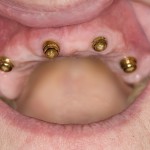
Historically dental implants were placed using a two-stage surgical protocol allowing the implant to osseointegrate and heal separate from the oral environment in order to reduce infection. Over time single stage approaches and differential loading times have developed.
The aim of this review was to compare the survival rate, postoperative complications, and marginal bone loss of non-submerged immediately loaded dental implants with those of submerged delayed loaded implants.
Methods
Searches were conducted in PubMed, Web of Science, and the Cochrane Oral Health Group Trials Register. This was supplemented by manual searches of a number of relevant dental journals. Clinical human studies, either randomized or not, comparing implant failure rates in any group of patients receiving submerged versus immediately loaded non-submerged dental implants were considered. Study quality was assessed using the Cochrane risk of bias approach. Three reviewers independently selected studies for inclusion. Implant failure (defined as complete loss) and post operative infections were evaluated.
Results
- 28 studies (6 RCTs; 14 CCTs; 8 retrospective analyses) were included
- 23 studies were considered to be at high risk of bias, 1 at moderate risk, and 4studies at low risk of bias
- Follow up periods ranged from 12 months to 10 years
- 3918 dental implants were non-submerged and immediately loaded, with 263 failures (6.71%)
- 7194 implants were submerged, with 446 failures (6.20%)
- The relative risk of failure when implants are immediately loaded compared to being submerged = 1.78 (95% CI; 1.12– 2.83)
- Only 7 studies reported on post-operative infection. There was no statistical difference in infection rates between submerged and immediately loaded implants, RR= 2.13 (95% CI; 0.52–8.65)
Conclusions
The authors concluded:
The difference between immediately loaded non-submerged dental implants and delayed loaded submerged implants statistically affected the implant failure rate. No statistically significant effects on the occurrence of post- operative infection or on marginal bone loss were observed between the two different techniques.
Comments
This is another meta-analysis of an aspect of dental implant treatment from the same group of authors. As in their previous reviews a range of different study designs have been included and contributed to their meta-analysis.
Their results are similar to an earlier review by Sanz-Sanchezet al (Dental Elf 3rd Sept 2014) finding that immediate loading may impose a greater risk for implant failure. However both these studies have included non-randomised studies and the earlier Cochrane review by Espositio et al (Dental Elf 10th April 2013) which was restricted to randomised controlled trials found no convincing evidence of a difference.
Links
Chrcanovic BR, Albrektsson T, Wennerberg A. Immediately loaded non-submerged versus delayed loaded submerged dental implants: A meta-analysis. Int J Oral Maxillofac Surg. 2014 Dec 23. pii: S0901-5027(14)00441-X. doi: 10.1016/j.ijom.2014.11.011. [Epub ahead of print] Review. PubMed PMID: 25541014.
Dental Elf – 8th Jul 2014 – Dental implants flapless or not?

submerged dental implants had fewer failures http://t.co/ZCl4W06PBL
Don’t miss: Submerged dental implants have fewer failures than immediate loaded implants http://t.co/TNnNT5SJGW #EBP
Dental Implants: submerged implants have fewer failures than immediate loaded non-submerged implants suggests review http://t.co/HFUgmD1I76
[…] Dental Elf – 3rd Mar- 2015 – Dental Implants: submerged implants have fewer failures tha… […]
[…] Dental Elf -3rd Mar 2015 – Dental Implants: submerged implants have fewer failures than im… […]